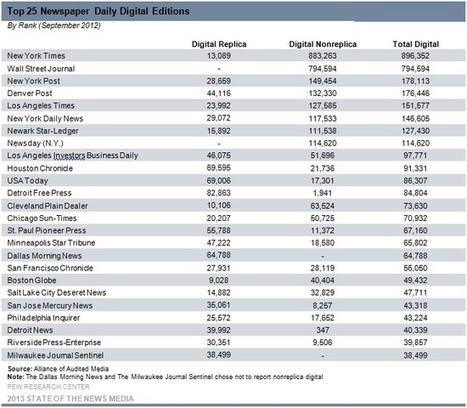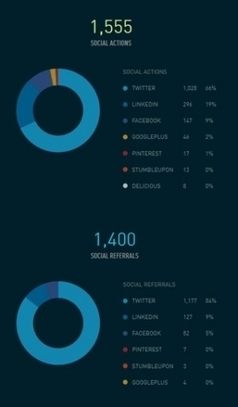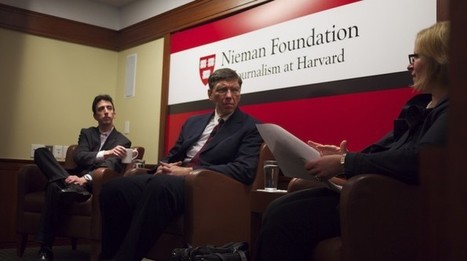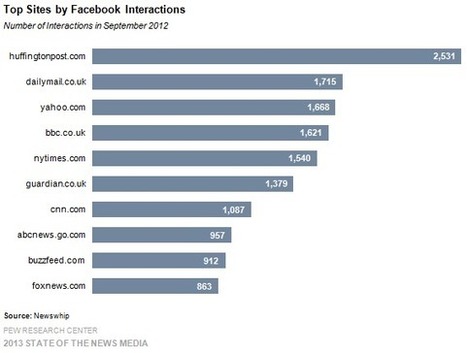 Your new post is loading...
 Your new post is loading...
Guardian digital development editor Joanna Geary answers some questions about GuardianWitness.... ...First up: this was built in two months. The sponsorship pot from EE gave them a budget and time to get the job done, but not necessarily have everything they wanted at launch. She says it's a complete, working system that can be built upon. I suggest the phrase "minimum viable product" to Jo but she suggests that it's a full product - one that will be built on. Do they have aspirations for more integration with social media? Yes, they do. And it's something they're looking at as the system develops. The key part of the development which is invisible to us right now is that the Guardian Witness system is deeply integrated with the Guardian's CMS. Once the content has passed through verification, it's available to the journalists, and they can insert it into a story or liveblog just by inserting an URL, which creates an embedded version of the contribution that links back to the contributor's profile. "The really exciting thing is not what you see now, but what you see when Witness is included in a story," she says. It's a tool to facilitate genuine collaborative working between the journalist and external witnesses. Jo says they'll collaborate with people on the ground, or with expert knowledge, in any way they can - and already do, via phone and other traditional methods. This adds another tool for doing that....
Terrible events such as yesterday’s bombings at the Boston Marathon have always meant “all hands on deck” for news organizations, with staffers pulled off their regular beats to contribute. But the endpoint of the newsgathering and reporting is no longer a front-page package of stories explaining — the best one can — what happened, why it happened and what might be next. Now, there is no endpoint — events are reported in real time, with stories in constant motion, and the front page is a snapshot of an organization’s reporting at the moment when the presses needed to roll. Boston was a reminder of that, and a look at what’s changing in real-time journalism. Through Twitter and various live blogs, I found myself looking over my shoulder at the Boston Globe, the New York Times, Reuters and other news organizations, and was able to make some observations and draw some conclusions....
...You can access the app via the Web, but there’s also native incarnations for Android and iOS. To contribute content to GuardianWitness, you need to create an account, either using your existing Guardian credentials, or through your Facebook and Twitter details. The Guardian actually posts ‘assignments’, inviting users to post content based on themes – for example, when Britain experiences unseasonably bad weather. Editors set a range of assignments each week, covering news, sport, culture and life and style....
...At their core, Facebook, Tumblr, and Twitter are sharing networks, not publishing companies. They act as platforms for other people’s content, which can be spread rapidly and massively among their communities. A consequence of being walled gardens that restricts this sharing activity within their own properties, however, is that they give up the right to decide when and how that content breaks free into the wider public discourse. Even though it had success with its partnerships program at placing stories into other forums, Storyboard’s stories always had the whiff of marketing, or what is these days being described as “native advertising.” As we now know, that ultimately did not work out for Tumblr. Going by Fletcher’s comments, perhaps Facebook Stories will meet a similar fate....
Don't be fooled by evangelists of 'free': editorial ethics and real reporting have been blown up along with the business model. Over at Slate the other day, Matthew Yglesias argued that journalism consumers are enjoying a "golden age". Yeah, sort of – in exactly the way looters enjoy an improved standard of living. Problem is, it only stays improved until the store is emptied out.
The news industry has gone from being obscenely profitable to slightly profitable to – at least, in the case of newspapers – largely unprofitable. All of that fantastic content Yglesias was gushing about is paid for by venture capitalists making bad bets, established media companies digging into their savings accounts to pay the bills, displaced workers earning peanuts, amateurs, semi-pros, volunteers and monks.
I would say that the business model is unsustainable, but losing money is not a business model. It is a going-out-of-business model....
If the newspaper industry had theme music in 2013, it might use “Been down so long it looks like up to me,” the much-recycled line from a 1920s blues song. For the first time since the deep recession that began in 2007, newspaper organizations have grounds for a modicum of optimism... Companies have started to experiment in a big way with a variety of new revenue streams and major organizational changes. Some of the bright opportunities – such as offering social marketing services to local businesses – are ventures too new to be measured yet industry-wide. They show signs of stabilizing revenue.... Even halting improvement in the general economy helps the industry. The double whammy of cyclical ad losses on top of secular shift to new media has considerably eased from the worst of the recession from 2007 to 2010. Auto advertising has come back, and some markets, like Miami, are beginning to see recovery in real estate and employment ads as well. All those positives, however, are for the time being mostly promise rather than performance. The most basic indicators have not turned around. The industry is little more than half the size it once was. Considerable dangers persist... So the industry entered 2013 with some positive signs but still dealing with difficult economic realities. The two biggest newspaper developments of the last year – digital paywalls and reduced print frequency – capture that odd mix of expansion and contraction now typical within the industry....
...The media loves to attach labels to trends. When one catches on, the rush begins. Native advertising (the buzzword of choice right now), social advertising, content marketing and sponsor curation all revolve around the notion of brands as publishers. Everyone’s jockeying for position, FORBES included. Marketers want a bigger voice. The media business needs revenue. The digital world demands change. So, what’s required for this new form of marketing — and for journalism to continue to flourish? Ah, here’s where the fun begins. Buzzfeed talks about viral content. The Huffington Post is into “aligning content and paid advertising strategies.”The Atlantic uses “Sponsor Content Presented By (pick the advertiser). Gawker’s done something similar (it’s actually now talking about a commerce play). As for us, I often talk about brand journalism. BrandVoice is based on the philosophical belief that marketers, with deep understanding of their industries, can offer smart insights, too. In most traditional media companies, that’s a tough sell. Journalists can barely swallow the advertorial — it must be placed in the print or digital equivalent of Siberia. The fact is is, with the click of a mouse or the touch of a screen, the audience can check a marketer’s veracity as easily as it can a journalist’s....
Two important but too-unsung women in media — performer Amanda Palmer and Google ad exec Susan Wojcicki — met at an idea this week: that media and advertising are becoming voluntary. They also touch on ideas I’ve been trying to write about: that media should be in the relationship business, not just the content business. In other words, media’s value isn’t necessarily intrinsic in content — as in, “you should pay for this product because the work to create it has value” — but can be realized in the relationships that form around content....
When to trust a theory over hard data, why companies that try to do too much get picked apart by competitors, and why sometimes industries have to learn the same lessons over and over. ...Skok said news organizations often do study their history, but they don’t focus enough on what’s coming next. Looking at profit and loss statements every quarter emphasize a snapshot of the past; Clay’s work says no, don’t only trust that balance sheet — trust a theory to predict what will happen in the future. But the idea of running large companies based on theories over hard numbers is a tough sell, Skok said. As disruption occurs, it commoditizes layers in the value stack — what used to be a high-value-added activity, one others couldn’t easily replicate, becomes cheap and easy. In journalism, the Internet, wireless technology, and other technologies have broadened the market for information. As a result, Christensen said, everyone has access to more information than they could possibly use. But that doesn’t mean that the whole indusry has become commoditzed and profitable: Commoditization opens up opportunities in adjacent layers in the value stack, he said. What you thought was a commodity becomes more profitable and proprietary — so even as one business dies, it opens up new opportunities. He cited the example of Forbes, whose previous core business — a print magazine — has been commoditized, but which has made interesting new moves online....
...As more people in any given newsroom are publishing to social platforms — andas more people bypass the homepage and instead use Twitter and Facebook as the entry point to any given news site — analytics companies see new opportunities to help media companies leverage real-time social data. Visual Revenue, a predictive analytics firm that focuses exclusively on media companies, is this morning rolling out a bundle of tools to help editors measure the effectiveness of social publishing in real time. “So, if you push a story right now on Nieman Lab, 40 clicks into it you might see 17 retweets, two favorites, some manual retweets and that’s all great, actually,” Visual Revenue CEO Dennis Mortensen told me. “But how do you really add all of it up?”...
...Ad-supported journalism is being consumed in record quantities, but those of us who manage media companies face a stark reality: Traditional advertising dollars in print and broadcast become dimes on the full-scale web, and they tend to disappear entirely on mobile devices. Alternative revenue models, then, are key to success, but only if they follow ethics guidelines that protect media outlets from losing credibility with readers. Sponsored content, as it is now being published on the full-scale and mobile web, differs from old-fashioned print advertorial in significant ways. The biggest departure is that, rather than passively receiving and publishing advertorial copy from ad agencies, media outlets are more often partnering with brands to create custom-content “native advertising” campaigns that resonate with readers who fit the publication’s demographic profile. BuzzFeed, for instance, employs a large staff to craft brand-marketing pieces that readers will share with friends via Facebook and other social networks. One such recent post, “11 Things No One Wants To See You Instagram,” quickly drew 330,000 views on behalf of advertiser Virgin Mobile, the Wall Street Journal reported. Similarly, Forbes Media created a Forbes BrandVoice program through which brands can submit paid articles to the Forbes website. “The advertiser-sponsored copy appears in the same style and format as articles contributed by Forbes writers and editors,” New York Post media columnist Keith J. Kelly reported in November. (The BrandVoice connection is noted at the top of posts.) This is a Wild West moment for sponsored content...
When a helicopter crashed in a densely populated part of London around 8am today, next to one of the busiest trainlines in Europe and a large bus station, the news was always going to be broken, within seconds, by members of the public on Twitter, armed with camera phones.
Twitter user Craig Jenner was one of the first to put a picture on Twitter which was shared far and wide.
What happened next is indicative of the way the media are increasingly playing catch-up on such stories, moving from reporting to aggregating (or curating, if you must) - images, eye-witness accounts and videos. Journalists were asking to use the picture with a credit and were trying to get Jenner on the phone...
A collaborative effort to figure out the future of journalism. A project of Harvard University. To close out 2012, we asked some of the smartest people we know to predict what 2013 will bring for the future of journalism. Here’s what they had to say.
|
In the wake of the Boston Marathon, I have but one ask for the media: please tell us NO.... ... While Twitter might offer up a 6-second video of one of yesterday’s horrific explosions, it’s your profession that is charged with relaying that information. In the race for clicks, pageviews, and traffic, I’ve seen the most trusted news sources with banner three-letter monikers devolve into sensationalized sites catering to this now now now generation’s demand for anything. “Anything — just give us anything,” we cry. But it would be lovely if you told us “no.” No – we will not capitalize on over-graphic images that would get a Hollywood blockbuster an R-rating. No – we will not use cultural or nationality indicators when reporting that there is a suspect in custody. Why? Because we know the most important words in those statements are “in” and “custody” as opposed to where one was born or the depth of one’s suntan....
“Twitter does its best work in the first five minutes after a disaster, and its worst in the twelve hours after that.” - @rolldiggity There is a quiet that descends in a newsroom when a big story breaks.... Twitter has often been touted as the “first with news”. From the miniscule to the massive. From Stephen Fry being stuck in a lift, to the Arab Spring rippling across North Africa, it is the instant source of a story, the first gurgle from a tap. The only way to find out what’s really happening, according to some. But I’m beginning to think that so-called truth is losing some of its polish. I follow about 700 people on Twitter. I actually “watch” about three times that amount. I have lists of people I don’t follow. In other words, I can see them, without having to follow them. News people, experts, specialists, comedians, doctors, police officers, bloggers and bohemians. I’ve been on Twitter for more than three years. I like to think I’ve found much of the gold within its mines. When the first tweets about the Boston marathon explosions popped up in my timeline, I went over to my newsroom colleagues. I told them what was happening. And the process began. And I watched Twitter....
... News is irrelevant. Out of the approximately 10,000 news stories you have read in the last 12 months, name one that – because you consumed it – allowed you to make a better decision about a serious matter affecting your life, your career or your business. The point is: the consumption of news is irrelevant to you. But people find it very difficult to recognise what's relevant. It's much easier to recognise what's new. The relevant versus the new is the fundamental battle of the current age. Media organisations want you to believe that news offers you some sort of a competitive advantage. Many fall for that. We get anxious when we're cut off from the flow of news. In reality, news consumption is a competitive disadvantage. The less news you consume, the bigger the advantage you have....
Traditionally, news readers first picked a publication and then looked for headlines that interest them. Google changed that process with its computer-generated Google News site. Google News aggregates headlines from many news sources, groups similar stories together and displays them according to each reader’s personalized interests. Articles are selected and ranked by computers that evaluate, among other things, how often and on what sites a story appears online. Google News also ranks based on certain characteristics of news content such as freshness, location, relevance and diversity. Google’s Maile Ohye further explains how Google News works in this video. Google News provides 100,000 business opportunities to publishers every minute or 4 billion clicks each month. They also have 50,000 competing publishers and with competition this fierce everything that can give you an edge counts. Here is a list of editorial tactics that journalists can employ to increase traffic from Google News....
When Facebook introduced its redesigned News Feed, it did more than change how people view memes and photos of cats — it altered the way stories are seen. Now everyone can make news. But for those who make a living by spreading news, Facebook has changed the way stories are presented. Dean Praetorius, a senior editor with The Huffington Post, talked with AllFacebook about how the way news is presented on Facebook requires some changes to the traditional approach. The Huffington Post has recently been lauded for its popularity on Facebook. Pew Research Center presented findings regarding news and social media, citing a study by Newswhip showing that the online newspaper was by far the most engaged news source on Facebook. In terms of Facebook interactions, HuffPost beat out more traditional companies, such as The Daily Mail, The New York Times, and CNN. How did HuffPost accomplish this? Praetorius said that the company has taken a well-rounded approach to social media, knowing that the story is far from completed when it’s published. HuffPost also thinks about stories differently from print media outlets and TV stations. Praetorius said that stories on the site are meant to generate conversation, and not so much to simply inform, as an old-school newspaper would...
As more consumers access news on their mobile devices, news organizations are seeing traffic to their websites from desktop computers flatten or decline. And in some regions, such as many parts of Africa, users are leapfrogging the Web altogether and going straight to mobile. Although many newsroom leaders believe a "mobile, too" approach -- a focus on mobile in addition to other platforms -- will be enough, that mentality is shortsighted, Bergman said in a recent Poynter Online chat. Joining Bergman to discuss the news industry's transition to mobile were Poynter's Regina McCombs and Damon Kiesow, senior product manager for mobile at the Boston Globe and Boston.com. The chat included several helpful tips for newsrooms making the transition to mobile....
Newspapers will never be the same. But what happens to democracy if the Web business model can't fund journalism? ...The assumption is that there has to be a way to make profits doing digital journalism if journalists and owners simply wise up and get with the program. Over the past few years, many American newspapers have been purchased on the cheap by hedge funds—nearly a third of the twenty-five largest dailies are now so owned—the subtext being that these business geniuses can generate profits where dummkopf journalism industry types have failed. As John Paton, the journalist-cum-CEO for a newspaper company purchased by the Alden Global Capital hedge fund in 2011, put it: “We have had 15 years to figure out the web and, as an industry, we newspaper people are no good at it.” Apparently, neither are the hedge fund managers. David Carr wrote in July 2012 that “hedge funds, which thought they had bought in at the bottom, are scrambling for exits that don’t exist.”...
BuzzFeed stir up a storm with a single, anonymous sourced story. Why? ...But as BuzzFeed has proved, one anonymous source does not merit a story, especially around a tricky topic. Basically, they published a story that challenged the accusations made by Michael Moore on Twitter that an Oscar nominated director was held at LAX for an hour and a half, with an anonymous LAX source challenging that, saying it was standard procedure and only lasted around 25 minutes.
The whole thing lead to a clash between Moore, Guardian columnist Glenn Greenwald, a few other new sites and BuzzFeed. Apparently, the anonymous source allows for wrong-doing to be covered up. This kind of reporting is becoming more common place though. In a world of digital first you never know when someone else might scoop your story. This means organisations run with what they have, as they have it....
Tech site develops predictive platform to monetize traffic surges In an analytics-obsessed Web climate, everyone is chasing the big story. The problem is, more often than not, big breakout traffic scoops yield attention, eyeballs and notoriety, but very few dollars. Last month, Deadspin broke the story on the Manti Te’o girlfriend hoax, netting the site nearly 4 million pageviews. But as Gawker Media mentioned publicly following the story, the company had no technical solution in place to monetize an unforeseen surge in traffic. Gawker is not alone. Web publishers have struggled across the board with this, which is why Ars Technica has been hard at work with what could be a viable solution. At Ars Technica, Condé Nast’s 15-year-old high-brow tech site, Ken Fisher and his small in-house team were lamenting the traffic conundrum when they decided to build a real-time dashboard geared toward examining pageviews with a predictive eye toward recently posted articles that are poised to trend. "Within two days we found it was working really well," explained Ars editor in chief Fisher. “We were identifying within an hour stories that would go on to do 900,000 views. And these were not pieces you’d hear by title and think, ‘That’s going to be killer.’ One was titled, Quantum Networks May Be More Realistic Than We Thought.”...
Newsweek's top editors faced a different kind of danger than the Flying Wallendas. Katharine Graham, publisher of The Washington Post and owner of Newsweek, made a habit of decapitating her editors. ...Very few “star” journalists of that time and space have made the trip to the digital world. Most of those I spoke with and saw are pretty much doing what they did 20 and 30 years ago. They’re doing it for traditional media companies that haven’t changed much either, although executives at each have convinced themselves otherwise. Those no longer working romanticized about the past. The experience also reminded me of something I repeatedly told Tim Forbes three or four years ago when I was deep into my startup, True/Slant. “There’s a new wave of of talent out there that’s going to blow past traditional journalists — and they don’t even see it coming.”
We’re fortunate to have members of that new wave at FORBES. They do their jobs differently, particularly when freed from hierarchical editing systems to build their own brands and be accountable for their own success. They relate to and engage with the audience unlike a past generation of reporters who could care less what readers thought (after all, what do they know?). Using the tools of social media, they follow their colleagues as competitive beat reporters to gain insight from them. Most important, they banter with them in full public view, a far more raw, if not real, version of any “news analysis” than shows up in newsprint. Sometimes, they even ride the crest of a competitor’s scoop by filtering it through their own eyes for different audiences. They produce their own videos, photos and galleries and podcasts to extend their reach. And they trust in Google, angling stories (and a story’s headline) to give them the best chance of reaching the world. In the video below, six people who sit in our newsroom talk about their jobs and the FORBES model of digital journalism.
...So, all in all, it’s more than instructive to check in on longform newspaper writing, and the start of a new year isn’t a bad time to do it. And it’s pretty to shocking to see what’s become of the time-honored form since the newspaper industry’s great unraveling started a decade ago. The Los Angeles Times, for instance, published 256 stories longer than 2,000 words last year, compared to 1,776 in 2003—a drop of 86 percent, according to searches of the Factiva database. The Washington Post published 1,378 stories over 2,000 words last year, about half as many as 2003 when it published 2,755. The Wall Street Journal, which pioneered the longform narrative in American newspapers, published 35 percent fewer stories over 2,000 words last year from a decade ago, 468 from 721. When it comes to stories longer than 3,000 words, the three papers showed even sharper declines. The WSJ’s total is down 70 percent to 25 stories, from 87 a decade ago, and the LA Times down fully 90 percent to 34 from 368....
Social media management has grown from a curiosity to anintegral piece of effective social media strategy in the space of just a few years. Nearly overnight, companies have brought on whole teams of specialists to craft effective social media strategies and manage multiplying numbers of social media accounts. Companies will be hungry for better social media management tools in 2013, too....
|



 Your new post is loading...
Your new post is loading...































This is an exciting development for citizen journalism and is definitely one that other newspapers and the entire industry should be watching closely. CNN already has more than 1 million iReporters and this type of engagement between media and audiences is surely the way of the future.